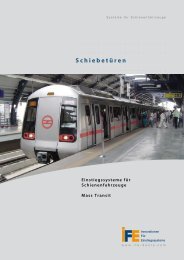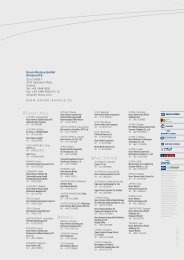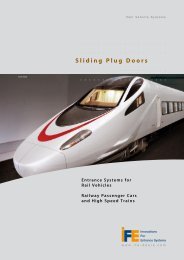Annual Report 2010 - Knorr-Bremse AG.
Annual Report 2010 - Knorr-Bremse AG.
Annual Report 2010 - Knorr-Bremse AG.
You also want an ePaper? Increase the reach of your titles
YUMPU automatically turns print PDFs into web optimized ePapers that Google loves.
RepoRt<br />
115<br />
Two pillars provide mutual support<br />
A key role here is played by the fact that the Group’s two separate business areas, rail vehicles and<br />
commercial vehicles, are subject to different economic cycles that can take very different courses – in<br />
terms of time and from one region to the next. Thus in times of crisis the two pillars provide mutual<br />
support and mitigate the overall impact of the cyclical global market. The fact that the company’s<br />
product portfolio has been expanded beyond the core field of braking also helps to safeguard its longterm<br />
future. Its innovative products in the areas of engine management, HVAC, power electronics or<br />
automatic door systems stand for reliable leading-edge technology at its finest.<br />
International strategy a stability factor<br />
In <strong>2010</strong> <strong>Knorr</strong>-<strong>Bremse</strong> maintained its global strategic focus with a broad-based position in numerous<br />
markets. <strong>Knorr</strong>-<strong>Bremse</strong> invested not only in product development but also in strategically important<br />
production facilities such as the new Rail Vehicle Systems plant in Budapest, Hungary, or the new<br />
Commercial Vehicle Systems plant in Liberec, Czech Republic. The agencies rated this diversification in<br />
terms of both regions and product groups as an additional stability factor in mitigating the effects of<br />
cyclical crises.<br />
Dependable planning<br />
<strong>Knorr</strong>-<strong>Bremse</strong>’s documented continuity in meeting or exceeding agreed targets over a long period of<br />
time was considered by the rating agencies proof of a solid and consistent management performance.<br />
A moderate financial policy is key to this management approach. The Group’s balance sheet structure<br />
and cash flow generation are geared to stability and sustainability and supported by an appropriate<br />
volume of short and medium-term committed lines of credit that are by no means taken up in full.<br />
Should the need arise, however, these credit facilities could bridge the gap between cash flow generation<br />
and cash requirements, ensuring the flexibility that the company needs if it is to generate a<br />
rapid response.<br />
Appropriate level of debt<br />
The rating agencies both affirm that <strong>Knorr</strong>-<strong>Bremse</strong>’s credit facilities are strictly aligned with the company‘s<br />
core business and in keeping with its economic capabilities. No speculation takes place.<br />
Through their ratings, Moody’s und Standard & Poor’s confirm that in times of crisis and of larger external<br />
acquisitions, the Group is always capable of generating sufficient cash flow to ensure that its level<br />
of net debt remains appropriate or, as was the case in <strong>2010</strong>, can be transformed into net liquidity.




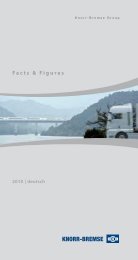

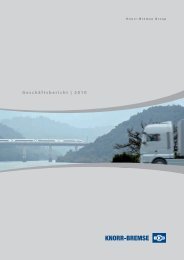
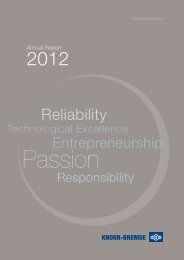
![Geschäftsbericht 2012 [PDF, 13 MB] - Zelisko](https://img.yumpu.com/22524926/1/184x260/geschaftsbericht-2012-pdf-13-mb-zelisko.jpg?quality=85)

